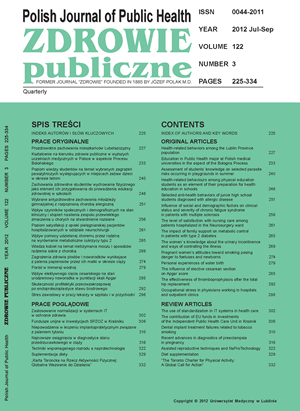The women's knowledge about the urinary incontinence and ways of controlling the illness
DOI:
https://doi.org/10.12923/j.0044-2011/122/3/a.09Keywords:
women, urinary incontinence (UI), non-invasive treatmentAbstract
Introduction. The urinary incontinence (UI) is considered one of the most often occurring chronic diseases in wo-men. It consists in uncontrolled leakage of urine through the urethra. It concerns 17-60% of the female population.
Aim. The main aim of the present work was to investigate women’s knowledge about the problem of urinary incontinence and its practical application dealing with the problem, what would contribute to improving the quality of life.
Material and methods. There were 101 female patients surveyed from the Zamość Rehabilitation Center of University of Management and Administration. The population was diversified with regard to age, place of living and education. The age of the examined women varied from 30 to 87 years. The research tool used was an author`s questionnaire survey. In the statistical analysis of the results Microsoft Excel program was applied. The significance level was accepted for p<0.05.
Results. For 69.31% respondents it was the embarrassing problem, but for 30.69% it was not. According to 35.64% women the age is the factor which influences UI to the highest degree. Next are the previous pregnancies (27.72%), hard physical labor (12.87%), frequent infections of the urinary tract (11.88%), genetic factors (8.91%), and excess weight (2.97%). The methods of dealing with the problem which respondents list most frequently are: exercises (37.62%), using of inserts/ sanitary towels (27.72%), pharmacotherapy (13.86%), operation (10.89%), avoiding effort (1.98%), frequent emptying, Botox, limiting consumption of drinks (0.99%).
Conclusions. In the opinion of the investigated women, UI was an embarrassing illness, often concealed, so the availability of information should be easier, both in urban and in rural areas. In both tested groups the respondents stated that UI exerted a negative influence on different spheres of life and on a quality of life, so it should be emphasized here that it is a social-economic problem. The tested women knew different methods of dealing with UI, but they didn`t know about such non-invasive methods as electrotherapy or biofeedback therapy. The women especially exposed to UI were those who were multipara. That is why a thoroughly prepared informing program about UI should be conducted among those women.
References
1. Rechberger T. Rola tkanki łącznej w etiopatogenezie nietrzymania mo-czu u kobiet. In: Materiały Sympozjum Naukowego Sekcji Ginekologii Operacyjnej PTG. Białystok; 1999. p.31-7.
2. Bo K. Urinary incontinence, pelvic floor dysfunction, exercise and sport. Sports Med. 2004;34:451-64.
3. Culligan PJ, Goldberg RP, Sand PK. A randomized controlled trial comparing a modified Burch procedure and a suburethral sling: long term follow up. Int Urogynecol J Pelvic Floor Dysfunct. 2003;14:229-33.
4. Bujnowska-Fedak M, Kassolik K, Andrzejewski W, Steciwko A. Nietrzymanie moczu. In: A. Steciwo. Fizjoterapia w chorobach układu moczowo-płciowego. Wrocław: Wydawnictwo AWF; 2004. p.74-9.
5. Rechberger T, Skorupski P. Nietrzymanie moczu – problem medyczny, socjalny i społeczny. In: T. Rechberger, J. Jakowicki (ed). Nietrzymanie moczu u kobiet patologia diagnostyka leczenie. Lublin: Wydawnictwo BiFolium; 2005. p .29-38.
6. Bo K. Risk factors for development and recurrence of urinary incontinence. Curr Opin Urol. 1997;7:193-6.
7. Thom DH, Eeden SK, Brown JS. Evaluation of parturition and other reproductive variables as risk factors for urinary incontinence in later life. Obstet Gynecol. 1997;90:983-9.
8. Swift SE, Tate SB, Nicholas J. Correlation of symptoms with degree of pelvic organ support in a general population of women: what is pelvic organ prolapse? Am J Obstet Gynecol. 2003;189:372-9.
9. Wlażlak E, Surkont G. Wybrane aspekty leczenia farmakologicznego nietrzymania moczu. Przew Lek. 2005; 2:62-73.
10. Aukee P, Usenius JP, Kirkinen P. An evaluation of pelvic floor anatomy and function by MRI. Eur J Obstet Gynecol Reprod Biol. 2004;112:84-8.
11. Pannu HK, Genadry R, Kaufman HS. Computed tomography evaluation of pelvic organ prolapse. Techniques and applications. J Comput Assist Tomogr. 2003;27:779-85.
12. Tunn R, Petri E. Introital and transvaginal ultrasound as the main tool in the assessment of urogenital and pelvic floor dysfunction: an imaging panel and practical approach. Ultrasound Obstet Gynecol. 2003;22:205-13.
13. Strupińska E. Fizjoterapia w nietrzymaniu moczu – techniki i metodyka ćwiczeń. Prz Urologiczny. 2007;46:17-9.
14. Surkont G, Wlażlak E, Stetkiewicz T, et al. Wpływ różnych sposobów analizy efektów leczenia nieoperacyjnego wysiłkowego nietrzymania moczu na końcowe wnioski. Prz Menopauzalny. 2005;4:77-82.
15. Kegel A. Progressive resistance exercise in the functional restoration of perineal muscle. Am J Obstet Gynecol. 1948;56:238-49.
16. Paczkowska A, Friebe Z, Koszla M. Skojarzone leczenie mieszanych postaci nietrzymania moczu elektrostymulacją i biofeedback. Prz Urologiczny. 2002;6:57-9.
17. Koszla M. Fizjoterapia szansą dla pacjentek z NTM. Kw. NTM. 2006;1:4.
18. Franek A. Nowoczesna elektroterapia. Katowice: Śląska Akademia Medyczna; 2001.
19. Łazowski J. Podstawy fizykoterapii. Wrocław: Wydawnictwo AWF; 2002.
20. Robertson V, Ward A, Low, Reed A. Fizykoterapia. Aspekty kliniczne i biofizyczne. Wrocław: Elsevier Urban & Partner; 2009.
21. Pages IH. Komplexe Physiotherapie der Weiblichen Harninkontinentz-Grundlagen, Durchfuhrung, Bewertung. Phys Med Rehab Kuror. 1996;2:19-24.
22. Williams KS, Assassa RP, Smith NK, et al. Educational preparation: specialist practice in continence care. Br J Nurs. 1999;8:1198-207.
23. Hunskaar S, Lose G, Sykes D, Voss S. The prevalence of urinary incontinence in women in four European countries. BJU Int. 2004;93:324-30.
24. Ogólnopolskie badanie „Polki wobec nietrzymania moczu” opracowane w kwietniu 2008 r. na grupie 300 kobiet cierpiących na nietrzymanie moczu. Badanie zrealizowano na zlecenie firmy SCA Hygiene Products, organizatora ogólnopolskiego programu edukacyjnego „CoreWellness – wewnętrzna siła”.
25. Agency for Health Care Policy and Research (AHCPR). Urinary incontinence in adults. Acute and chronic management. US Department of Health and Human Services. Public Health Service. Agency for Health Care Policy and Research. AHCPR publication No. 96-0682;1996.
26. Villet R, Salet-Lizee D, Zafiropulo M. Wysiłkowe nietrzymanie moczu u kobiet. Warszawa: PZWL; 2003.
27. Kwon CH, Culligan PJ, Koduri S, et al. The development of pelvic organ prolapsed following isolated Burch retropubic uretrophexy. Int Urogynecol J Pelvic Floor Dysfunct. 2003;14:321-5.
28. Jolleys JV. Reported prevalence of urinary incontinence in women in a general practice. Br Med J. 1988;296:300-2.
29. Thomas TM, Prymat KR, Blannin J, Meade TW. Prevalence of urinary incontinence. Br Med J. 1980;281:1243-5.


